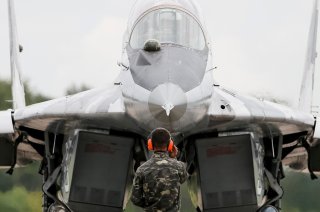Can Ukraine's Revamped Armed Forces Stand Up to a Russian Invasion?
Military power is dangerously lopsided in Moscow's favor.
As tensions mount in the ongoing military standoff between Russia and Ukraine, Western intelligence sources are warning that the Russian forces gradually massing along Ukraine’s eastern border could strike at any moment. But what form can such an attack possibly take, and how would Ukraine’s military fare in a direct military confrontation with its Russian neighbor?
Ukraine’s Armed Forces have undergone substantial reforms since the pitched fighting of 2014-2015, evolving into a relatively regimented and well-disciplined institution. The Ukrainian military has likewise undertaken several ambitious procurement programs to modernize or replace its aging Soviet inheritance, including a major Bayraktar TB2 combat drone procurement deal with Turkey, an effort to produce the advanced Neptune anti-ship cruise missile platform, and the development of a Ukrainian variant of the T-64 second-generation main battle tank (MBT)—the T-64BV.
Yet the balance of forces is still overwhelmingly skewed in Russia’s favor. Ukraine has roughly 250,000 active military personnel, versus Russia’s tally of over one million. Ukraine currently possesses just under 2,500 active tanks, as compared to Russia’s 13,000. Kiev’s T-64BV, while a major improvement over the baseline T-64 model, is unlikely to fare well against such newer Russian tanks as the T-80BVM and T-90M. Similar patterns can be observed in the categories of armored vehicles and self-propelled artillery—Ukraine’s military boasts 11,435 and 785 respectively, against Russia’s 27,100 and 6,540. Russia’s Black Sea Fleet poses a significant threat against Ukraine’s strategically vital southern coastal cities and can even strike targets embedded further up north, all with little military recourse available to the Ukrainian side.
The air power comparison is no less dangerously lopsided in Russia’s favor; Ukraine’s ragtag coterie of less than one hundred 1960s and 1970s Soviet aircraft is in no position to contest Ukrainian airspace against Russia’s vast, echeloned network of air/missile defenses and robust roster of modernized bombers and jet fighters.
These differences are borne out in concrete dollar amounts; Ukraine spends about $5.2 billion on defense, as opposed to Russia’s $65 billion. As significant as these force disparities appear on paper, they would be even more pronounced in practice. In any sort of pitched conflict scenario, Russia’s military is positioned to swiftly degrade and destroy large swathes of Ukrainian industrial and military infrastructure—power stations, airfields, command headquarters, etc.—with a series of coordinated precision and saturation strikes, crippling Kiev’s ability to repel the invading Russian ground forces.
All of the available data suggests that the initial stages of a westward Russian incursion will result in overwhelming losses for the defending Ukrainian troops. But what happens afterward is a different story, one that heavily depends on how exactly Moscow chooses to go about a prospective invasion of Ukraine. Experts widely agree that a prolonged Russian occupation of all Ukraine would be catastrophic for Moscow, bogging down the invading forces in a politically, morally, and militarily debilitating guerilla conflict that cannot be meaningfully won.
Mark Episkopos is a national security reporter for the National Interest.
Image: Reuters

